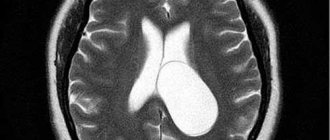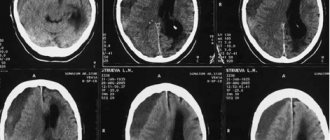Brain inflammation is a very serious pathology, which is characterized by the death of nerve cells and damage to the nervous system.
The disease may be infectious or allergic in nature. In most cases, it develops as an independent disease, but can be the result of a previously suffered pathology.
It is possible to defeat the disease with a timely diagnosis and competent immediate treatment.
Types of brain inflammation
Depending on the location of the lesion, there are two types of inflammation of the brain - encephalitis and meningitis.
Inflammation of the cerebral cortex can manifest itself in acute, subacute and chronic forms.
Each of them has its own specific manifestations and, accordingly, different treatment tactics.
Meningitis
With this disease, an inflammatory process of the lining of the brain develops; it can be provoked by:
- viruses;
- bacteria;
- fungi.
It is very important to recognize the first symptoms of meningitis in children in time - this can save the child’s life!
Encephalitis
With this pathology, the substance of the brain becomes inflamed. Depending on the form of the disease, it can be severe and lead to death or mild.
According to medical statistics, the disease is more often observed in childhood.
There are primary and secondary encephalitis. In the first case, the disease can develop after a tick bite, influenza or herpes.
The secondary form develops as a complication of certain diseases, namely:
- rubella;
- chicken pox;
- malaria;
- measles
Also, a secondary form of encephalitis can become a complication after vaccination.
Encephalitis caused by tick bites
This is the name for inflammation of the brain, triggered by a neurotropic virus, the main sources, and ixodid ticks are also considered to be its carriers. The patient becomes infected through transmission, through a tick bite. But alimentary infectious transmission cannot be ruled out if a person, for example, drank raw milk or ate dairy products from infected animals.
Seasonality is inherent in tick-borne encephalitis, that is, it corresponds to the activity of ticks. Most often this happens in May-June. Not every tick that attaches itself to human skin is a carrier of the virus. But since it is never possible to tell by sight, if you find a tick on your skin, you should immediately contact the nearest medical facility. The tick will be removed and sent for examination. Alas, often the applicant himself must take the tick to the laboratory at his own expense - but in a situation with a bite, it is still better to do this.
How the disease develops
When a tick bites its victim, the virus immediately appears in the blood. It ends up in the central nervous system due to hematogenous dissemination and viremia. The virus can be detected in the brain structures already two days after infection, but the virus reaches its maximum content on the fourth day.
The latent period lasts 1-3 weeks, the nutritional route of infection reduces this figure to 4-7 days
.
What a detailed examination shows:
- Hyperemia and swelling of the brain matter and membranes of the brain tissue are recorded;
- Gliotic and also mesodermal reactions;
- Infiltrates from polynuclear and mononuclear cells;
- Localization of degenerative-inflammatory deformations - in the anterior horns of the cervical spinal cord, the nuclei of the medulla oblongata, as well as the pons and cortex;
- The chronic stage of the disease is characterized by fibrous deformations of the membranes of the brain with the appearance of adhesions and cysts.
In people bitten by an encephalitis tick, an inapparent form of FE is found, only in two percent is it clinically indicated.
The disease has a sudden onset: fever, intoxication, severe hyperthermia, migraine, nausea and weakness, vomiting, problems sleeping.
The disease may go away in 3-5 days. This applies specifically to the febrile form of the disease, which is considered perhaps the most common, and yet it is rarely diagnosed. The NS is not affected in this form of EC.
Other forms of FE
In the meningeal form of the pathology, a general cerebral syndrome is recorded. Rigidity of the neck muscles is clearly manifested, Brudzinski and Kernig's symptoms occur. If changes are found in the cerebrospinal fluid, serous meningitis is diagnosed. This disease has a favorable course - the fever does not last more than two weeks.
CE can proceed in another way:
- In the meningoencephalitic form, the disease is more severe. The patient himself is sleepy, lethargic, very lethargic, and suffers from headache and nausea. He is often delirious, has hallucinations, and has a confused consciousness. The nerves that innervate the facial and oculomotor muscles are affected (outwardly the face becomes skewed).
- In the polyradiculoneurotic form of CE, peripheral nerves and roots are affected, and sensitivity is impaired.
- In the polio form of the disease, the signs are as follows: “dangling head”, as well as “limbs hanging along the body”, “dropping shoulder girdles”. There will be no complete recovery; some neurological disorders will persist.
The prognosis is very different; they are most favorable for the meningeal form. But there are cases when the acute phase quickly gives way to coma and the disease ends in death. Widespread prevention of CE gives good results - there are few severe cases associated with threatening inflammation of the meninges of the brain. More precisely, such forms began to be observed less frequently.
People's awareness has increased, they use tick repellents, and react correctly if a bite is detected.
Causes of brain inflammation
A person can experience brain inflammation at any age.
According to medical statistics, children and middle-aged men are more likely to suffer from inflammatory brain disease. The development of this disease can be caused by a number of factors - from back and head injuries to certain types of infection. Among the main reasons are:
- severe hypothermia;
- infectious diseases, including tick-borne encephalitis virus.
A secondary form of brain inflammation can occur for the following reasons:
- chronic ENT diseases – sinusitis, sinusitis, frontal sinusitis;
- severe form of pneumonia;
- conjunctivitis;
- chicken pox suffered in adulthood;
- previously suffered meningitis or encephalitis, not completely cured.
As a rule, the inflammatory process develops as a result of various pathogens entering the brain tissue through the circulatory system.
The pathogen can penetrate through the air, the digestive system, or through contact with a sick person. An insect bite (tick bite, for example) that transmits tick-borne encephalitis is also dangerous.
Consequences in children
The impact of coronavirus infection on pregnant women and the fetus has not been studied at all. According to the former head of the department of microbiology of latent infections of the National Research Center for Epidemiology and Microbiology named after N.F. Gamaleya, Professor Viktor Zuev , “flu is very dangerous for the fetus, it passes through the placenta. And we need to find out whether the coronavirus is able to persist in the body of pregnant women, overcome the placental barrier and cause infectious processes in the fetus.”
Children as a result of coronavirus infection may develop Kawasaki syndrome (necrotizing systemic vasculitis with predominant damage to medium and small arteries). It most often affects infants and children under five years of age, but exceptions are possible. A new dangerous syndrome also occurs in older children and is accompanied by fever, rash, swelling, damage to the skin, eyes, heart and blood vessels, as well as infectious-toxic shock. The syndrome is dangerous due to damage to the arteries with the possible formation of aneurysms, thrombosis and ruptures of the walls of blood vessels.
Since the majority of those who have recovered from Covid-19 are currently still undergoing rehabilitation, it is not yet known what serious health consequences the coronavirus infection brought to each of them. But it is already becoming clear to specialists that health will not be the same even among those patients who have had Covid-19 in a mild or asymptomatic form.
In order to prevent coronavirus infection and its serious complications, experts recommend leading a healthy lifestyle, strengthening the immune system, observing the rules of personal and public hygiene, and strictly following the instructions regarding compliance with the mask and glove regime and distancing.
Main symptoms
Symptoms indicating inflammation of the brain are quite varied.
Signs of brain inflammation depend on the type of pathology, stage of the disease and localization of the source of inflammation. Most of the symptoms are the same for both meningitis and viral encephalitis. Among the external visible first signs:
- general weakness and constant malaise;
- regular and prolonged attacks of severe headaches;
- vomiting attacks; high body temperature and hallucinations;
- pain in muscles and joints, cramps.
The manifestation of neurological symptoms is expressed as follows:
- stiffness in the joints and loss of coordination of movement;
- change in consciousness;
- violation of the swallowing process;
- problems with articulation;
- eye movement disorders.
The manifestation of symptoms in the mental sphere is expressed in the following:
- increased anxiety;
- the appearance of insomnia;
- frequent mood changes;
- the occurrence of hallucinations.
Mental disorders arise suddenly and manifest themselves in the form of delusions and psychoses. The patient may experience a psychomotor agitated state in which he behaves inappropriately and cannot independently control his actions.
In the case of a secondary type of pathology and the development of complications, the disease develops rapidly, and the symptoms manifest themselves much more strongly. In this case, the patient exhibits the following symptoms:
- pain becomes stronger, almost unbearable for the patient;
- intracranial pressure increases;
- the complexion becomes darker;
- there is acute sensitivity to bright light and smells;
- small rashes and red spots appear on the skin;
- sweating increases.
Similar symptoms can develop within a day, the patient experiences delirium and convulsions.
Immunity
Those who have recovered from Covid-19 experience long-term immune dysfunction. A decrease in the level of lymphocytes in the blood, which can be either temporary or long-term, is a typical symptom in patients who have had a coronavirus infection. However, even after recovery, patients may experience changes in the number of blood cells responsible for the body’s protective functions. Lymphopenia (a persistent decrease in blood lymphocytes) is a typical symptom in patients with Covid-19, even 4-11 weeks after recovery.
Russian experts say that SARS-CoV-2, unlike the human immunodeficiency virus, cannot multiply in lymphocytes. Therefore, disruptions in immunity may be reversible.
Diagnostics
You should consult a doctor and undergo the necessary diagnostic examination immediately after the first signs and unpleasant symptoms appear.
Diagnosis of the disease includes, first of all, a physical examination and study of the patient’s medical history and symptoms of the disease. Additional examination is required, which includes:
- lab tests. The following indicators will indicate the inflammatory process in the body: an increase in the number of leukocytes, lymphocytes, an increase in the erythrocyte sedimentation rate, an increase in the content of fibrinogen and C-reactive protein;
- cerebrospinal fluid examination. The puncture is taken by puncturing the spinal canal in the lumbar region. When the disease occurs, there is an increase in the number of immune cells, protein, and a decrease
- amount of glucose. In appearance, during the inflammatory process, the liquid is cloudy and yellowish;
- MRI. The procedure helps to accurately determine the location of the source of inflammation.
In addition, it is worth noting that MRI can detect a number of dangerous pathologies, such as, for example, a cancerous brain tumor at an early stage.
Treatment
When the first symptoms of a brain disease appear, you should contact an ambulance, whose doctor should refer the patient to hospitalization and administer appropriate medications that will help temporarily reduce swelling of the brain.
The treatment course depends on the diagnostic results and the diagnosis made. Symptoms of brain inflammation may be similar to those of other diseases, as a result of which proper treatment is prescribed and begins much later.
The course of therapy includes the following methods of treating inflammation:
- etiotropic therapy - intended to eliminate the causes of the inflammatory process;
- pathogenetic direction - the use of drugs that stop processes leading to damage to brain tissue;
- Symptomatic therapy can reduce the manifestations of the disease.
The following drug therapy may be prescribed:
- To combat the pathogenic infection, antibacterial drugs are prescribed. As a rule, the course lasts at least 10 days, and the drug is administered as an injection;
- if the disease is of viral origin, it is necessary to take antiviral medications;
- taking antibiotics will be ineffective in case of a fungal disease. In this case, it is recommended to take antifungal drugs;
- Diuretics may be prescribed to relieve swelling;
- in case of seizures, anticonvulsant medications are prescribed;
- When the temperature rises and a febrile state, antipyretic drugs are prescribed.
The patient is recommended to be hospitalized in a specialized medical facility to ensure constant monitoring of breathing and the functioning of the cardiovascular system.
Under no circumstances should you self-medicate. It is very important to start proper treatment on time and as quickly as possible; every minute counts, since the consequences of brain inflammation are serious. Incorrect treatment can worsen the situation and lead to death.
In children, the disease is more severe than in adults; their bodies are not yet strong enough to fight such a terrible pathology.
Treatment of brain inflammation depends on the patient’s condition, symptoms and course of the disease. In any case, treatment should be comprehensive and under constant medical supervision.
After the course of treatment has been completed and the patient’s condition has improved, the patient needs rehabilitation measures. This will help reduce the effects of damage to brain tissue. During the recovery period, auxiliary rehabilitation measures are recommended: physical therapy classes, a massage course, physiotherapeutic procedures.
Possible complications
Inflammation of the brain in any of its manifestations is a very dangerous disease, especially its secondary form, which can lead to serious consequences and complications. The following possible consequences may occur with cerebral edema:
- hearing impairment;
- vision problems and development of strabismus;
- mental development disorder;
- memory impairment;
- the occurrence of epileptic seizures;
- problems with coordination of movements;
- cardiac dysfunction;
- coma.
The main danger is death.
If left untreated, the patient may die within a week. There is also a possibility of such an outcome if you seek medical help late. Inflammation of the brain can be mild, but there is still a risk of complications, so it is important to promptly pay attention to the appearance of symptoms and consult a doctor promptly.
Lungs, respiratory organs
According to the Russian Ministry of Health, the most common clinical manifestation of the new variant of coronavirus infection is bilateral pneumonia. Acute respiratory distress syndrome (ARDS) has been reported in 3–4% of patients.
All viral pneumonia can have long-term consequences. First of all, this is pulmonary fibrosis, leading to significant loss of ability to work, even disability.
Coronavirus is very insidious. You need to closely monitor your health, especially those who have suffered from viral pneumonia. Over time, areas of compaction of lung tissue can turn into foci of fibrosis - dense tissue that “does not breathe.” Doctors do not rule out that those who have recovered from Covid-19 will suffer from shortness of breath for the rest of their lives, even with minimal physical exertion. Affected lungs will not be able to supply the body with the required amount of oxygen. Such structural changes in the lungs will require a long recovery.
Rospotrebnadzor recommends that people who have had Covid-19 undergo several control CT scans throughout the year measuring the density of lung tissue. If, based on the results of the study, it turns out that areas of compaction of the lung tissue have remained or expanded, rehabilitation is necessary. And this is not only breathing exercises, but also physiotherapy, inhalations, a set of aerobic exercises, and swimming.
Prevention
To prevent brain inflammation in any manifestation, special vaccines have been developed that produce immunity against viruses.
It should be borne in mind that it is impossible to completely protect yourself from the development of an inflammatory process in the brain, but you can reduce the risk of getting sick. To do this you need:
- adhere to a healthy lifestyle - give up bad habits, eat properly and nutritiously;
- exercise;
- prevent chronic forms of the disease - cure diseases on time and completely;
- try to avoid going out into nature during times of likelihood of an outbreak of encephalitis and tick activity.










